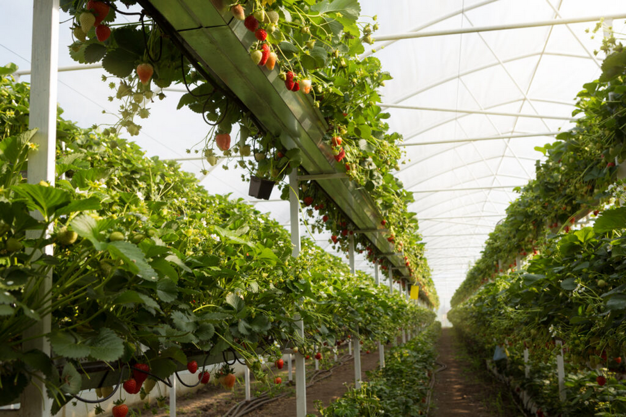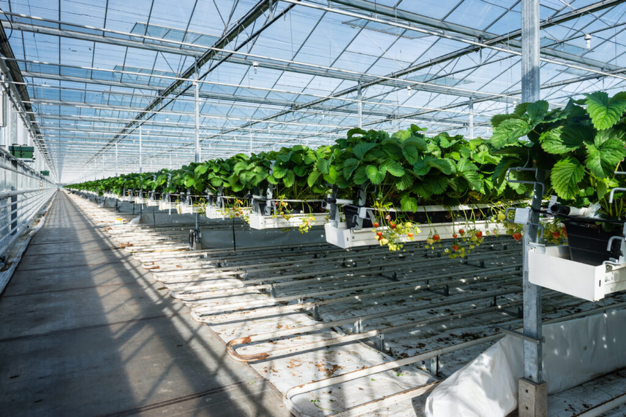Strawberries are a beloved fruit, known for their sweet flavor and vibrant color. Growing strawberries in a greenhouse can enhance the process, allowing farmers and gardeners to cultivate these delectable berries year-round.
Benefits of greenhouse-grown strawberries
Extended growing season – One of the most significant advantages of a greenhouse is the ability to control temperature and humidity. Outdoor strawberries are predominantly grown in spring and fall, as the plants like cooler temperatures. Many greenhouse growers grow from fall to spring to create ideal strawberry conditions – since it's easier to heat a greenhouse than cool it. Also, greenhouse-grown berries have the most market value outside of the traditional field growing season.
Pest and disease control – Greenhouses offer a controlled environment that can reduce the risk of pests and diseases. With the right management practices, you can minimize chemical use and promote healthier plants.
Optimal growing conditions – A greenhouse allows for precise control over light, temperature, CO2, and humidity. By optimizing these factors, you can produce larger, sweeter strawberries compared to those grown outdoors. The ability to create ideal growing conditions also means less crop loss from pathogens as well as birds and small animals that may affect outdoor strawberry crops.
Local farming – Growing strawberries in greenhouses significantly reduces food miles by enabling local production throughout the year, regardless of seasonal constraints. Instead of relying on imports from distant farms, which often require long transportation routes, greenhouse cultivation allows strawberries to be grown closer to consumers. Local production reduces crop loss since, on average, nearly 10% of mature strawberries are wasted during transportation to grocery stores. In addition, once harvested, strawberries begin to lose nutrients due to respiration, a process where they break down stored organic materials, leading to the degradation of flavor and nutritional content. The longer the time between harvest and consumption, especially during transportation, the more nutrients and flavor may be lost.
Variety selection – Greenhouses enable you to experiment with different strawberry varieties, including everbearing and day-neutral types, which can produce fruit multiple times throughout the year. This allows for more yield per square foot.

Ideal environmental conditions for greenhouse strawberries
Watering – Greenhouses allow for precision moisture control in a strawberry greenhouse. Strawberries prefer consistent moisture but hate soggy roots. Implementation of a properly designed irrigation system can help maintain ideal moisture levels while reducing the risk of fungal diseases. The most common irrigation method is using drip lines into pots or containers, but growers are also experimenting with NFT (nutrient film technique).
Temperature control – Greenhouses are ideal for strawberry growing because heating is one of the simplest functions of a greenhouse, and it allows for production throughout the winter. It's ideal to aim for daytime temperatures between 70°F to 75°F (21°C to 24°C) and nighttime temperatures around 60°F (15°C). Ventilation is crucial; the use of fans or open vents will prevent overheating.
Lighting – While strawberries thrive in full sun, greenhouse conditions can sometimes lead to excessive heat. Maintaining proper shading during the hottest months will prevent scorching. Shade systems allow greenhouse strawberries to be cultivated later in the spring earlier in the fall, and potentially through the entire summer. In winter, supplemental LED lighting allows strawberries to have ideal amounts of light, supporting optimal fruit production throughout the winter when the value for fresh strawberries is highest.
Pollination – Strawberries are typically self-pollinating, but increasing airflow can enhance pollination rates. Consider introducing bumblebees or using a small paintbrush to assist with pollination if necessary.

Growing systems for greenhouse strawberries
There are several different techniques for growing strawberries in a greenhouse. Each grower/gardener has a different preference based on the goals of their strawberry operation.
Fixed gutters – Fixed gutters come in two styles, ground mount or hanging. Hanging gutters allow for easier cleaning of the ground, but require that the greenhouse structure itself can handle the weight of the gutters filled with grow media, plants, and hopefully lots of berries. Ground mount gutters work the same way, but are supported by posts from the ground, allowing for a lighter-weight structure. Both systems have plants in a grow media of some sort, accompanied by drip irrigation (usually) for precision watering.
Mobile gutters in pots – Mobile gutters are a newer method for strawberry production. This method adapts technology from lettuce/greens growers and allows for a more dense plant canopy. With this technology, the gutters rotate towards the greenhouse workers instead of the workers having to move to the gutters. Usually, there is an area where workers plant the gutters and then the gutters move onto a moving rack conveyor, towards a harvesting zone where the gutters pass to be harvested. In a strawberry system, pickers will see each gutter every two to three days depending on the size of the operation and the speed the gutters are moving
Multi-layer system – A mobile gutter system can also allow for a multi-layer system, where a lower level of gutters is grown under LED lighting and then the plants move up to the upper layer with sunlight the other half of the time. While this does require more inputs (lighting and energy), it can double the production of berries in the same greenhouse footprint, which is often a worthwhile expansion.
Solutions
With the right techniques and environmental controls, cultivating strawberries in a greenhouse can yield impressive results. Now that we've explored the essential practices and systems for successful strawberry production, let's dive into how Ceres Greenhouse Solutions' greenhouse designs are tailored to optimize strawberry growth, ensuring maximum yield and quality for your operation.
At Ceres, solutions are created for growers using a combination of proven methodology, high-tech materials, and data. In our strawberry cultivation research, we have learned that two major factors that contribute to a successful commercial strawberry operation are reduced labor costs and lower heating costs.
Integrated automated gutter systems are an important piece of our larger-scale facilities. They allow for a much more dense plant canopy while keeping labor costs at a reasonable level (depending on the scale of the operation). The gutter systems are not "high tech", but are mechanical and have been proven over decades of greenhouse cultivation. These systems can also include irrigation and fertigation.
This combination of structure, systems, and controls allows growers to grow at least 9 months out of the year, if not year-round, in the most efficient way possible.
Source: Ceres Greenhouse Solutions
